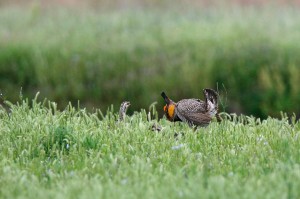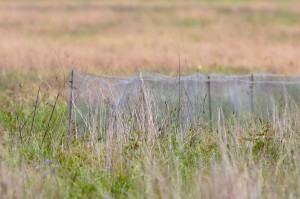At Padre Island National Seashore, it’s the Kemp’s ridley sea turtle that clambers up the beach to nest each summer. At Aransas National Wildlife Refuge, it’s the Whooping Crane that makes the coastal wetlands its only winter home.
And at Attwater Prairie Chicken National Wildlife Refuge outside of Houston it’s … a little obvious, isn’t it?
Unlike the showcase endangered species at the other parks, the Attwater’s Prairie Chicken is a permanent resident of the Katy prairie, but your odds of seeing one are much higher from late February through Early May, when the males prance around in their mating display. The rest of the year, they’re hunkered down in the tall grass.After a couple of unsuccessful early morning stakeouts on my own, I decided to take the refuge’s Saturday morning tour, which improves your odds because it ventures into more sensitive areas closed to daily visitors. The tours are every Saturday during the spring mating season and less frequently the rest of the year.
I met up with refuge wildlife biologist Rebecca Chester and nine other early birders at 7 a.m. on a late spring morning and we piled into a forest service van for a slow drive through the prairie. (If you arrive after 10 a.m., the show’s long over.)
The Attwater’s wild population is small – less than a hundred most of the time – but it varies by the time of year. It surges as hatchlings emerge and again in late summer when birds raised in captivity are released in the wild. Then it drops, sometimes precipitously, as predators and other environmental pressures whittle it back down.
So far, the refuge had identified about 30 nesting sites – a number that would climb some in the weeks ahead. On average, an Attwater’s Prairie Chicken hen will produce about a dozen eggs. But from there, things get dicey. Within six weeks of their hatching, most of them are gone.
The refuge managers take a lot of steps to protect the them. Once a nest is identified, they erect a perimeter of netting around it to exclude snakes, raccoons and other crawling predators. All of the hens have radio transmitters so they can locate them at any time with directional antennas attached to their trucks. When the hens are away foraging, refuge managers will measure and weigh the eggs, enabling them to closely estimate when they’ll hatch. All of the fence posts surrounding the breeding grounds are topped with metal spikes to keep raptors from getting a easy perch from which to stalk their prey.Despite their best efforts, the population is not making much headway. The problem is apparently not the raptors swooping down from above, but fire ants swarming from below. The ants don’t generally eat the young birds but have decimated the same insects that the hatchlings rely on in their first few weeks, effectively outcompeting them for food. The baby birds are not being eaten; they’re starving. And, unfortunately, many of us can testify to the challenges of eradicating fire ants.
(Confirming their suspicions, brood survival improved dramatically when rangers gathered up insects and provided them for some of the broods and again in one particularly wet year when the insect population on the refuge bloomed.)
In late summer, to further boost the population, anywhere from 200 to 300 birds raised at the Houston zoo and other locations are released into the refuge after being acclimated in huge outdoor enclosures. They, too, have a rough time, being not as adept at foraging or avoiding predators as their wild cousins.
So after hundreds of new birds hatch each year and hundreds more are released into the prairie, the population ends up back below 100 birds, as it did in a count earlier this year.
We heard the prairie chickens before we saw them – a low hum that pierced the rustling grasses. Called “booming”, it’s part of the elaborate courtship ritual of the male prairie chickens. They raise the feathers around their head, spread their tail, push their tush into the air, puff out their bright orange cheeks and stomp on the ground.
At first, all we saw were their heads poking above the vegetation, but every once in a while they’d pop out as they pranced back and forth. The first place we stopped, near a small pond, had at least five or six displaying males and at least three hens. They were in moderately tall grass at least 75 yards away, so we never got to see them from beak to toe.
As with most birds, the hens were a drab brown. They sat nearby acting as if they didn’t even notice the commotion going on around them. “Just like we did when we were in college,” one young birder chirped.
We spent almost an hour watching the display and glimpsed one other bird in a nearby field. Briefly distracted by a magnificent White-Tailed Hawk, we couldn’t find it again.
Although the tour is all about the prairie chickens this time of year, the refuge has a diverse population of birds, plants, flowers and wildlife that’s well worth the trip, even if you don’t get to meet the marquee species. In addition to the White-tailed Hawk we came across an unusually large flock of Green Herons along the creek, a graceful Scissor-tailed Flycatcher and sweetly chirping Dickcissels that seemed to be everywhere. A jackrabbit darted into the grass and then hunkered down, waiting for us to pass. Every so often, the van flushed a handful of Bobwhite Quail that scurried down the side of the road only to get flushed again when the van caught up with them.
A few weeks earlier, the refuge was a wash of pastel colors. Although now past their peak, the remaining Indian Paintbrushes, Evening Primrose and other wildflowers still made a splash.


You must be logged in to post a comment.